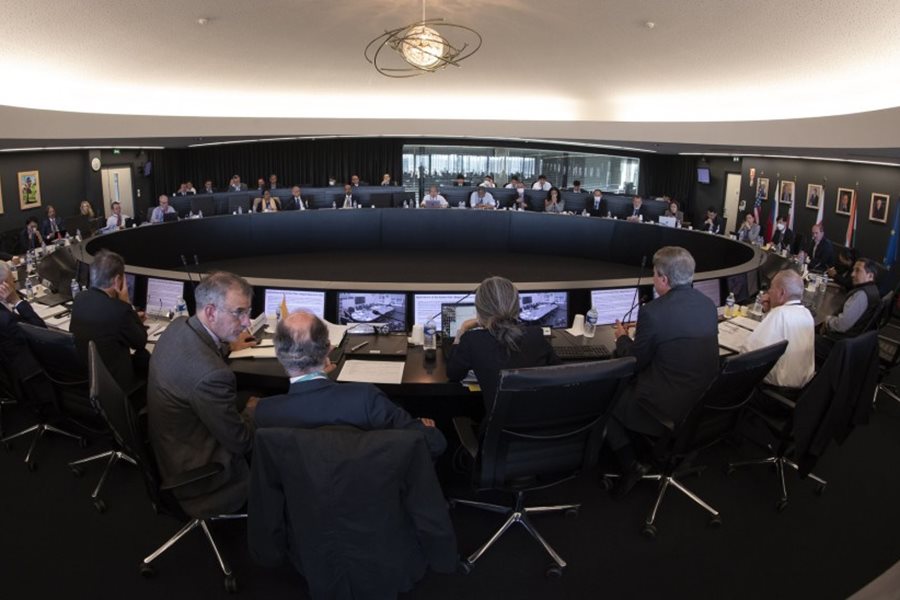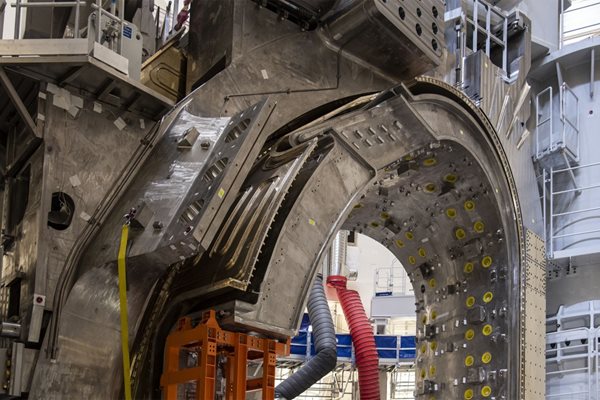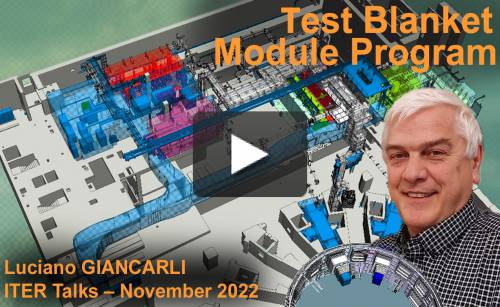
you're currently reading the news digest published from 14 Nov 2022 to 21 Nov 2022
featured2
of-interest1
video1
press20
featured
31st ITER Council | Addressing challenges
The project's governing body, the ITER Council, convened for the 31st time in its history on 16 and 17 November to evaluate the progress of construction, manufacturing, assembly, and commissioning. Meeting in a hybrid format, with one Member attending by videoconference, delegations from China, the European Union, India, Japan, Korea, Russia, and the United States reviewed the efforts of the ITER Organization and the Domestic Agencies as they work together to coordinate the delivery, assembly and installation of components. The Council noted the ongoing fabrication and delivery of first-of-a-kind components, including most recently the departure for shipment of poloidal field coil #1; the progressive installation of plant support systems, including the installation of all magnet conversion equipment required for First Plasma and the initiation of subsystem commissioning for the cryogenics facility and cooling water plant; and onsite construction works, including substantial progress on the Tritium Building, the Control Building, and the Neutral Beam Power Supply buildings. It also noted the need to address a number of concerns related to First-of-a-Kind components (see the related article in this issue). In particular, recent results from analysis of key components indicated the need for extensive repairs. The Council urged the Director-General to assess the impacts of these setbacks and commence the necessary repair work as soon as possible. In addition, the Council urged the ITER Organization and Domestic Agencies to work together to ensure an appropriate project-wide quality culture to prevent any recurrence of such issues. Council Members reaffirmed their strong belief in the value of the ITER mission, and resolved to work together to find timely solutions to facilitate ITER's success. The Council noted the ongoing pressures facing the project and encouraged all ITER Members to meet their in-kind and in-cash commitments to enable implementation of the construction, installation and assembly strategy. See the full press release in English and in French.
Machine assembly | Key components to be repaired
When building a machine as large and as complex as ITER, difficulties and setbacks do not come as surprises—they are an integral part of manufacturing, assembling and installing first-of-a-kind components. From the first stages of fabrication to the final insertion in the Tokamak pit, component challenges are a constant and familiar companion. Sometimes, however, in the midst of ordinary, almost daily issues, a concern of a larger dimension arises—one which demands in-depth examination, creativity in devising corrective actions, and time and budget to repair. Two and a half years into its machine assembly phase, ITER is facing a concern of this nature: defects have been identified in two key tokamak components, the thermal shields and the vacuum vessel sectors. The vacuum vessel thermal shields and the cryostat thermal shields are actively cooled silver-plated elements, 20 and 10 millimetres thick respectively, that contribute to thermally insulating the superconducting magnet system operating at 4K, or minus 269 °C. In each of the nine vacuum vessel modules—one of which is already installed in the machine assembly pit—thermal shield panels are positioned in the narrow gap between the vacuum vessel sector and the two associated toroidal field coils. A circular thermal shield, approximately 20 metres in diameter, also lines the inner wall of the cryostat to complete the heat barrier protecting the superconducting magnetic system. The lower section of the cryostat thermal shield was positioned inside the pit in January 2021. In November 2021, helium tests detected leaks on an element of the vacuum vessel thermal shield that had been delivered a year and a half earlier. Working groups with experts from different ITER partners were rapidly established to investigate, and they were able to identify the root cause for the leaks—stress caused by the bending and welding of the cooling fluid pipes to the thermal shield panels, compounded by a slow chemical reaction due to the presence of chlorine residues¹ in some small areas near the pipe welds. This reaction had generated what is called 'stress corrosion cracking' and, over time, cracks up to 2.2 millimetres deep had developed in the pipes. A crucial question therefore arose: was the issue a one-off problem, limited to the elements examined, or was it systemic, affecting all thermal shield components? 'The risk is too high, and the consequences of a leaking thermal shield panel during operation are too dire. We must assume the problem is extensive,' says ITER Director-General Pietro Barabaschi. 'Dealing with it in the pit on the module that has already been assembled would be enormously difficult. This means we have to lift out the installed module and disassemble it in order to proceed with the repairs. We are exploring different possibilities, from on-site repair to re-manufacturing in an outside facility, possibly with different pipe attachment options. But there is no question about the need to replace the cooling pipes.' (The problem is less acute for the cryostat thermal shield panels because their cooling pipes are easier to access.) Whereas this thermal shield issue is now thought to be essentially due to a weakness in the design of the cooling pipe attachment, which made it impossible to fully wash away the chloride residue, vacuum vessel sector issues stem from a more common industrial fabrication difficulty: the distortion that invariably occurs in welding processes, compounded by the overall complexity of the ITER vacuum vessel sectors. In ITER, as in many complex technological objects, fabrication is based on tri-dimensional computer-assisted blueprints. In the ideal world of 3D design, a component's dimensions are by definition nominal and parts fit together like cogs and gears in a pricey wristwatch. In the real world of industry, however, things are different: deviations during the manufacturing process are inevitable and may lead to 'non-conformities' that need to be addressed. ITER, like any industrial venture, deals with such matters on a daily basis. When a finalized component is made of several sections individually machined and welded together, and when it is as tall as a six-storey building like the ITER vacuum vessel, dimensional non-conformities are on par with the component's size. In the case of the three vacuum vessel sectors that have already been delivered, the welding of the component's four individual segments caused deviations from nominal dimensions that were more substantial than the specified limit in different locations on the component's outer shell. These dimensional non-conformities modified the geometry of the field joints where the sectors are to be welded together, thus compromising the access and operation of the bespoke automated welding tools. Despite ongoing coactivity in the assembly pit's restricted space and particle contamination risks, solutions were initially contemplated to execute repairs in situ, without extracting the vacuum vessel module from its present position. 'The thermal shield issue has now changed the perspective,' says the ITER Director-General. 'As we need to disassemble the module to fix the thermal shield piping, the question of whether or not to repair the vacuum vessel sector in the pit becomes irrelevant. We have no other solution but to remove it.' As repair strategies for both components are being refined, schedule scenarios established, and costs estimated, the present sequence of vacuum vessel assembly is now on hold. 'We know what we need to do, we know ways to do it, and we are of course very much aware of the consequences as far as schedule and cost are concerned—and they will not be insignificant.' 'If there is one 'good thing' about this situation,' the Director-General adds, 'it is that it is happening at a moment we can fix it. The knowhow we are acquiring in dealing with ITER's first-of-a-kind components will serve others when they launch their own fusion ventures. It is in ITER's nature and mission, as a unique and ambitious research infrastructure, to go through a whole range of challenges and setbacks during construction. And it is therefore our task and duty to promptly inform the engaged scientific community so that they will take precautions when dealing with the same type of assemblies.' ¹ Prior to receiving their silver plating, thermal shield panels are cleaned with hydrochloric acid and then coated with nickel. It is during this process that chlorine residues were trapped in tiny pockets near the pipe welds and slowly corroded the component's material.
of-interest
2021-2022 photobook: JAPAN Edition
The Japanese Domestic Agency has released a JAPAN Edition of the 2021-2022 ITER Organization photobook. The main difference from the original? A significantly expanded gallery of manufacturing photos from Japan. See pages 76 to 90 for an idea of the broad expertise and knowhow that ITER Japan suppliers are bringing to bear in completing their commitments to the ITER Project. Powerful gyrotron devices, robotic manipulators, advanced diagnostics, precise divertor targets, superconducting magnets ... view, or download, the JAPAN Edition of the 2021-2022 ITER Organization photobook here.



